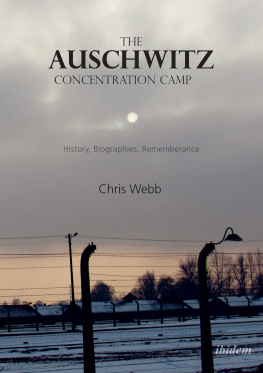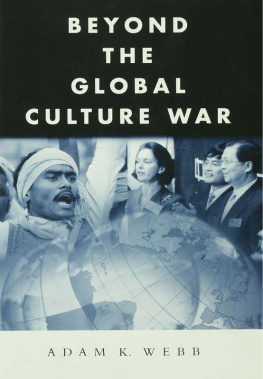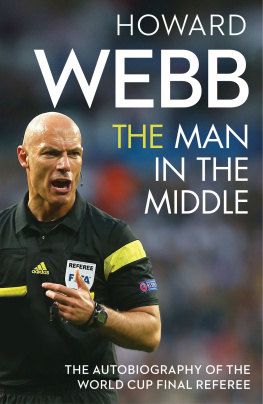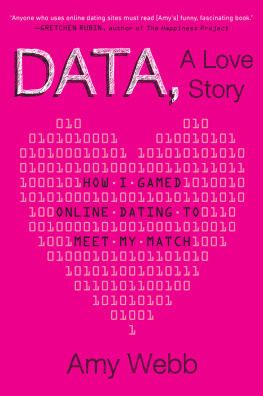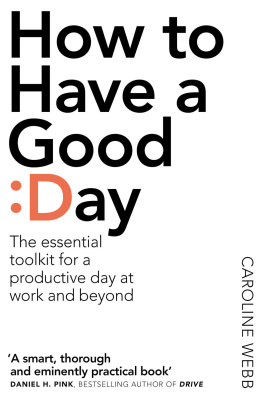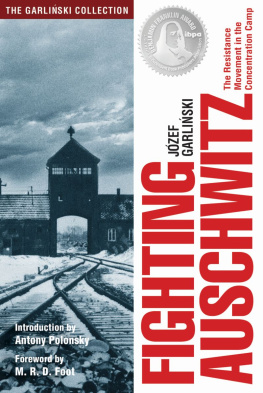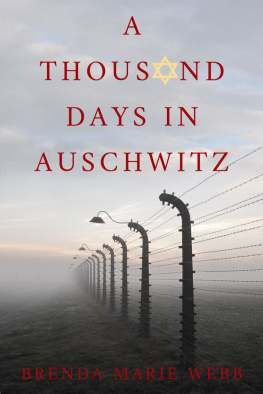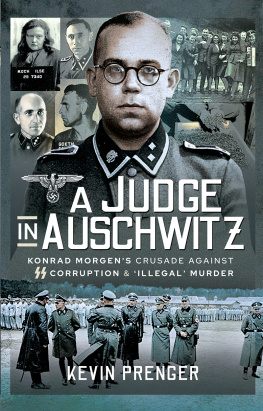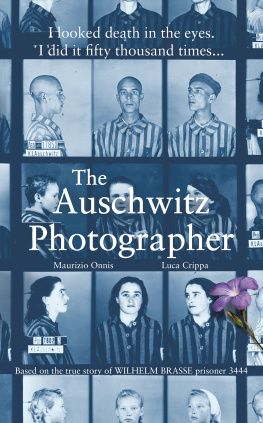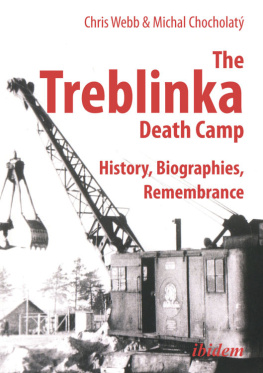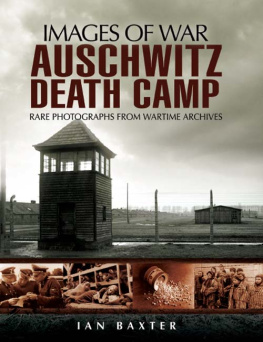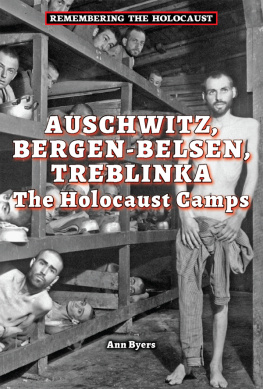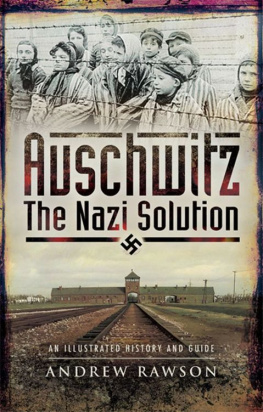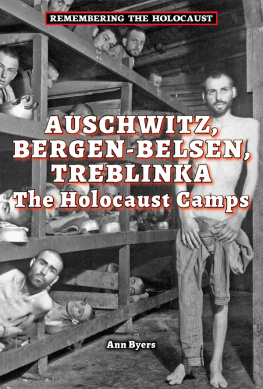ibidem Press, Stuttgart
Contents
Dedicated To :
Mr Marian Koszewski from KocianSurvivor of Auschwitz and Gusen camps.
I met him in Kocian in September 2005, thanks to Artur Hojan and Cameron Munro.
Frank Bright who survived Auschwitz, although his Father and Mother did not.
He kindly shared the story of the Brichta family with me, part of which is included in this book.
For Freya Isabel
I therefore became Commandant of the Quarantine Camp which was to be built at Auschwitz.
It was far away, in the back of beyond, in Poland.
Rudolf Hss
Commandant of Auschwitz
We had read the name of Auschwitz on the labels on the truckstrucks or wagonstrucks. But nobody of us knew
what Auschwitz meant.
Primo Levi
Italian Jew who was deported to Auschwitz in 1944,
but survived.
Foreword
I have known Chris Webb since 2003. I myself had been involved in Holocaust research for many years prior to this, though on a purely private basis. It was in 2003 that I came across the Aktion Reinhardt Camps (ARC) website. I sent an inquisitive email to the website enquiring about becoming a member. A very enthusiastic response came back from Chris, welcoming me to the fold.
The website was run on a very devolved basisif you wanted to contribute something you went ahead and did it. There was some proof checking and review of facts, but those who wanted to contribute could. And so the website and interest grew. It generated the most extensive research undertaken to date on the three Aktion Reinhardt Camps. As I was to discover, it was Chris who was the real driving force behind the website.
We met for the first time on the ARC field trip to Poland in 2004 and we have met several times each year since then, as well as undertaking research trips to Poland and the United States of America, and swapping research material and ideas by email. Chris has always provided excellent feedback on my research efforts. He has been researching the Aktion Reinhardt Camps and the Holocaust in general for over 40 years.
I have met many researchers and talked to many institutes of Holocaust research around the world. Almost all agree that the ARC website is still the most comprehensive and user-friendly website on the Holocaust. Since the ARC website was frozen some years ago, existing on the web but not being added to, Chris has moved on to other projects, including setting up H.E.A.R.T. and the Holocaust Historical Society. He has also written a trilogy of books on Beec, Sobibr and Treblinka, that have been published by Ibidem-Verlag and he has self-published other Holocaust related works.
Chris joined the Tiergarten 4 Association in 2015, of which I am the Chairman and founder. The Tiergarten 4 Association is a Berlin registered association which researches and publishes works on Nazi war crimes, with a focus on the Warthegau, Chemno, Aktion Reinhardt Camps, gas vans, Sonderkommando 1005, other Concentration Camps, euthanasia institutes and War crimes trials. The Tiergarten 4 Association has an extensive library of some 20,000 books and more than a million pages of original documents relating to the Nazi period and War crimes trials. Some of these documents have been consulted in producing this book on Auschwitz.
Chris has also very generously given his time and expertise to Holocaust education in the UK. He has given many lectures at Universities and has more recently acted as a consultant and guide to Auschwitz and Krakw, where he has imparted his knowledge about the Camp in particular and the Holocaust in general. It is thus an opportune moment for Chris to publish his book on The Auschwitz Concentration Camp, History, Biographies, Remembrance.
As with all of his works, in his book on the Auschwitz Concentration Camp, Chris produces a fine balance between detailing the sufferings of the victims and the actions and characters of the perpetrators. He manages in a concise form to give an excellent overview of all aspects of Auschwitz and its many complex of camps.
The book will be useful both for those coming to the Holocaust for the first time, and those seasoned researchers like myself, who have read many books on Auschwitz. Although the number of existing published works on Auschwitz is vast, this book on the Auschwitz Concentration Camp is a very worthy addition to the bibliography of one of the most important Camps established by the Nazis.
Cameron Munro
Tiergarten 4 Association
Berlin
March 2017
Authors Introduction
The AuthorAuschwitz-Birkenau January 2017
Photograph: Taken By Mark Handscomb
This book was inspired by my recent visits to Auschwitz-Birkenau whilst acting as a guide for the University of Teesside in 2016 and 2017. I have now visited the site four times and every visit brings new things to learn and understand. It remains a sobering and humbling experience, from my first visit in 2004, up to the current day, and these experiences will stay with me for life.
This book has been constructed using the excellent book by Danuta Czech, Auschwitz Chronicle to tell the chronological history of the Concentration Camp, from its conception in 1940 to its demise in 1945. This is the best way to chart the development of the police Camp which became the greatest cemetery without a grave in the history of mankind. Whilst the Chronicle has been used as the foundation, accounts from both survivors and members of the Camp garrison, some of which have never been published in book form to date, tell the heartbreaking story of life and death, in the most infamous of places, created by man.
This work covers the establishment of the Camp, its development from a Security Police prison holding Polish political prisoners to the industrial mass killing of a large portion of the Jewish race in Europe. The story is told from all sides; the Polish prisoners, the Jews, the Germans, the Resistance workers, the survivors and the victims, the heroes and the villains. Biographies of the perpetrators and remembrance for both the survivors and the victims. Chronological tables of the deportations and details of some of the survivors, and the post-war statements and Trials, all tell the story of the hell called Auschwitz.
My first visit to Auschwitz was made in 2004, as part of a group visiting many of the major Holocaust related sites, including former Camps such as Paszw, Treblinka, Sobibr, Beec, Trawniki, Poniatowa, and Majdanek. I was lucky enough to be guided around Auschwitz by the Swedish expert Brje Hallstrm, who joined us on the trip. He had visited the Camp and the surrounding area many times before, and he passed on his knowledge freely, for which I am most grateful.
In terms of thanking people, I would first like to thank Tom Nixon from Teesside University who designed the book cover, with such consummate skill. I was delighted to renew my working relationship with Tania Mhlberger, who once again proof read and copy edited this book in her exemplary style, I am blessed to know her. For introducing me to Tania and for being instrumental in the great privilege of inviting me to work with Teesside University, I must thank Professor Matthew Feldman. Our long standing friendship is a source of much joy. I must also thank Mark Handscomb and Lucy Jolly, for our three trips to Auschwitz, along with the students from Teesside University who made the journey to Poland. Mark very kindly took some photographs of me on the ramp in Birkenau, in freezing weather in January 2017, specifically for this book.

